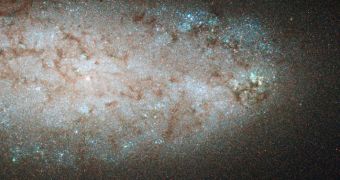Ever since last May, when astronauts aboard the space shuttle Atlantis repaired and upgraded the Hubble Space Telescope, the renowned observatory has been snapping a host of incredible photos of our Universe. One such image is of a galaxy that is relatively close to the Milky Way, whose shape and structure has been puzzling astronomers for a long time. Now, thanks to the new investigations by Hubble, the mystery related to the peculiar structure appears to have been cleared, Wired reports.
NGC 2976 is so unusual, that experts have been wondering how it came to look the way it does. Because it lies just some 12 million light-years away from the Earth, our telescopes can get a good look at it, and observe its structure in intimate detail. Amateur astronomers with powerful telescopes can also observe the structure, in the constellation Ursa Major. Observations have shown a sand grain-like appearance for most of the galaxy's surface, and astrophysicists have been at a loss with regard to explaining exactly how that developed. In the recent Hubble observations, experts were able to use data extrapolated from the brightness and color of the stars in NGC 2976 to create a history of its evolution.
According to researchers, the galaxy was subjected to massive interactions from the M81 group of galaxies. This group features the interacting M81 and M82, alongside NGC 3077, which also appears to be in a collision process with the other two. The gigantic structure that is formed is enveloped in a common cloud of gases. The team behind the new investigations reveals that M81 triggered the stellar formation in NGC 2976 billions of years ago, but adds that something happened about 500 million years ago. At that time, it reveals, most stellar nurseries in the galaxy stopped producing new stars.
The outer galaxy was most affected by this phenomenon. The area was left completely without the ability to produce new, blue stars, so only older, redder ones were left. One of the reasons why this happened could be that large amounts of cosmic gas – which is absolutely indispensable to the production and ignition of new stars – were stripped away from the galaxy as it interacted with the M81 group. The only part of NGC 2976 that still produces stars is located close to its core, and expands over a region of just 5,000 light-years, which is very small. The team also determined that the grains that appeared to make up the galaxy were, in fact, individual stars. The stellar nursery that is still active is the one featuring the blue star, to the upper-central part of the image.

 14 DAY TRIAL //
14 DAY TRIAL //